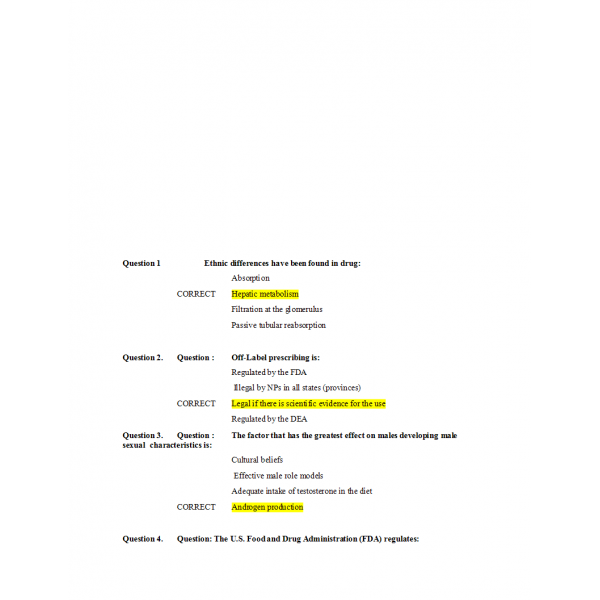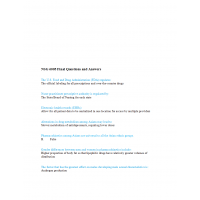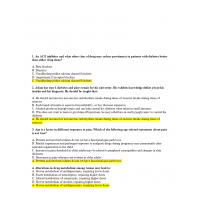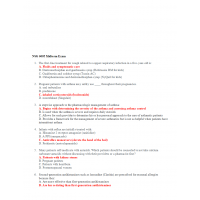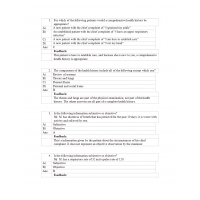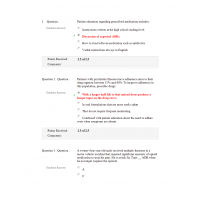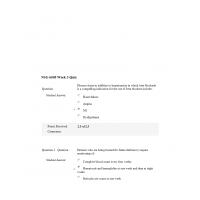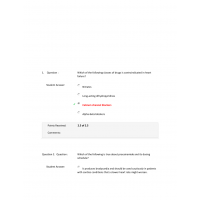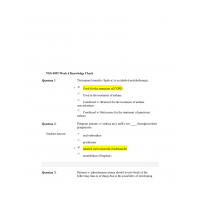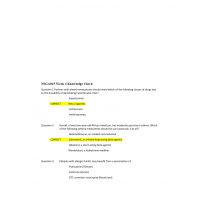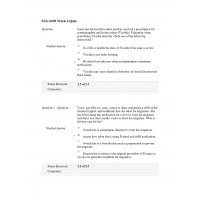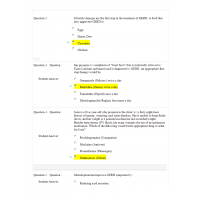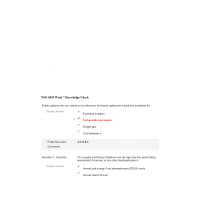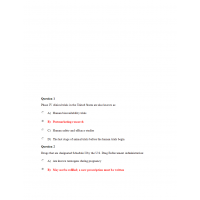NSG 6005 Week 1 Knowledge Check - Pharma
NSG 6005 Final Questions
- The U.S. Food and Drug Administration (FDA) regulates:
- Nurse practitioner prescriptive authority is regulated by:
- Electronic health records (EHRs)
- Alterations in drug metabolism among Asians may lead to
- Pharmacokinetics among Asians are universal to all the Asian ethnic groups.
- Gender differences between men and women in pharmacokinetics include:
- The factor that has the greatest effect on males developing male sexual characteristics is:
- An advantage of prescribing a sublingual medication is that the medication is:
- Infants and young children are at higher risk of ADRs due to:
- Pharmacokinetic factors that affect prescribing include:
- Carbamazepine has a Black Box warning recommending testing for the HLA-B*1502 allele in patients with Asian ancestry prior to starting therapy due to:
- Genetic polymorphisms account for differences in metabolism, including:
- A patient may develop neutropenia from using topical Silvadene for burns. Neutropenia is a(n):
- The elderly are at high risk of ADRs due to:
- The time required for the amount of drug in the body to decrease by 50% is called:
- The angiotensin converting enzyme (ACE) inhibitor lisinopril is a known teratogen. Teratogens cause Type ____ ADR
- Common OTC pain relievers such as acetaminophen or ibuprofen:
- A patient’s nutritional intake and lab work reflect hypoalbuminemia. This is critical to prescribing because:
- Warfarin resistance may be seen in patients with VCORC1 mutation, leading to:
- The first step in the prescribing process according to the World Health Organization is:
- A nurse practitioner would prescribe the liquid form of ibuprofen for a six-year-old because:
- The point in time on the drug concentration curve that indicates the first sign of a therapeutic effect is the:
- When obtaining a drug history from Harold, he gives you a complete list of his prescription medications. He denies taking any other drugs, but you find that he occasionally takes aspirin for his arthritis flare-ups. This is an example of
- Which one of the following statements about bioavailability is true?
- Beta blockers treat hypertension because they:
- Which of the following is true about procainamide and its dosing schedule?
- Dulcea has type II diabetes and a high triglyceride level. She has gemfibrozil prescribed to treat her hypertriglyceridemia. A history of which of the following might contraindicate the use of this drug?
- Patients who have angina, regardless of Class who are also diabetic should be on ?
- Donald has been diagnosed with hyperlipidemia. On the basis of his lipid profile, atorvastatin is prescribed. Rhabdomyolysis is a rare but serious adverse response to this drug. Donald should be told to:
- ACE inhibitors are the drug of choice in treating hypertension in diabetic patients because they:
- First-line therapy for hyperlipidemia is:
- Isosorbide dinitrate is a long-acting nitrate given twice daily (BID). The schedule for administration is 7 a.m. and 2 p.m. because
- Jamie is a thirty-four-year-old pregnant woman with familial hyperlipidemia and elevated LDL levels. What is the appropriate treatment for a pregnant woman?
- Heart failure is a chronic condition that can be adequately managed in primary care. However, consultation with or referral to a cardiologist is appropriate when:
- Rodrigo has been prescribed procainamide after an episode of MI. He is monitored for dyspnea, jugular venous distention, and peripheral edema because they may indicate:
- Compelling indications for an ACE inhibitor as treatment for hypertension based on clinical trials include:
- Which of the following disease processes could be made worse by taking a nonselective beta blocker?
- The American Heart Association and the American College of Cardiology have devised a classification system for heart failure that can be used to direct treatment. Patients with symptoms and underlying disease are classified as:
- Phil is a fifty-four-year-old male with multiple risk factors who has been on a high-dose statin for three months to treat his high LDL level. His LDL is 135 mg/dL, and his triglycerides are elevated. A reasonable change in therapy would be to:
- Which of the following drugs has been associated with increased risk for MI in women?
- Treatments for heart failure, including drug therapy, are based on the stages developed by the American Heart Association and the American College of Cardiology. Stage A patients are:
- A potentially life threatening adverse response to ACE inhibitors is angioedema. Which of the following statements is true about this adverse response?
- A stepwise approach to the pharmacologic management of asthma:
- A patient with a COPD exacerbation may require:
- The first-line treatment for cough related to a upper respiratory infection in a five-year-old is:
- When treating a patient using the “step-down” approach, the patient with GERD is started on ____ first
- In five- to eleven-year-old children, mild-persistent asthma is diagnosed when asthma symptoms occur:
- When using the “step-up” approach in caring for a patient with GERD, the “step up” from OTC antacid use is:
- If a patient with H. pylori positive PUD fails first-line therapy, the second-line treatment is:
- Cough and cold medications that contain a sympathomimetic decongestant such as phenylephrine should be used cautiously in what population:
- Howard is a seventy-two-year-old male who occasionally takes diphenhydramine for his seasonal allergies. Monitoring for this patient taking diphenhydramine would include assessing for:
- Treatment failure in patients with PUD associated with H. pylori may be due to:
- Sadie is a seventy-two-year-old who takes omeprazole for her chronic GERD. Chronic long-term omeprazole use places her at increased risk for:
- Many patients self-medicate with antacids. Which patients should be counseled to not take calcium carbonate antacids without discussing with their providers or a pharmacist first?
- Patients with allergic rhinitis may benefit from a prescription of :
- Tiotropium bromide (Spiriva) is an inhaled anticholinergic:
- Prior to developing a plan for the treatment of asthma, the patient’s asthma should be classified according to the National Heart, Lung, and Blood Institute (NHLBI) Expert Panel 3 guidelines. In adults, mild-persistent asthma is classified as asthma symptoms that occur:
- Pregnant patients with asthma may safely use ____ throughout their pregnancies.
- Patients with pheochromocytoma should avoid which of the following classes of drugs due to the possibility of developing hypertensive crisis?
- Josie is a five-year-old who presents to the clinic with a forty-eight-hour history of nausea, vomiting, and some diarrhea. She is unable to keep fluids down, and her weight is 4 pounds less than her last recorded weight. Besides intravenous (IV) fluids, her exam warrants the use of an antinausea medication. Which of the following would be the appropriate drug to order for Josie?
- Judy is being prescribed phenytoin for seizures. Monitoring includes:
- When a patient is on selective-serotonin reuptake inhibitors:
- Jaycee has been on escitalopram (Lexapro) for a year and is willing to try tapering off of the selective-serotonin reuptake inhibitors. What is the initial dosage adjustment when starting a taper off antidepressants?
- Cecilia presents with depression associated with complaints of fatigue, sleeping all the time, and lack of motivation. An appropriate initial antidepressant for her would be:
- Jake, a forty-five-year-old patient with schizophrenia, was recently hospitalized for acute psychosis due to medication noncompliance. He was treated with intramuscular (IM) long-acting haloperidol. Besides being monitored for his schizophrenia symptoms, the patient should be assessed by his primary care provider:
- Selma, who is overweight, recently started taking topiramate for seizures and at her follow-up visit you note she has lost 3 kg. The appropriate action would be:
- An appropriate first-line drug to try for mild to moderate generalized anxiety disorder would be:
- When prescribing Adderall (amphetamine and dextroamphetamine) to adults with ADHD the nurse practitioner will need to monitor:
- Cynthia is taking valproate (Depakote) for seizures and would like to get pregnant. What advice would you give her?
- Levetiracetam has known drug interactions with:
- A nineteen-year-old male was started on risperidone. Monitoring for risperidone includes observing for common side effects, including:
- Sarah, a forty-two-year-old female, requests a prescription for an anorexiant to treat her obesity. A trial of phentermine is prescribed. Prescribing precautions include understanding that:
- Prior to starting antidepressants, patients should have laboratory testing to rule out:
- Jack, eight years old, has attention deficit disorder (ADD) and is prescribed methylphenidate (Ritalin). He and his parents should be educated about the side effects of methylphenidate, which are:
- An appropriate drug for the treatment of depression with anxiety would be:
- The tricyclic antidepressants should be prescribed cautiously in patients with:
- Anticholinergic agents, such as benztropine (Cogentin), may be given with a phenothiazine to:
- Six-year-old Lucy has recently been started on ethosuximide (Zarontin) for seizures. She should be monitored for:
- Henry is eighty-two years old and takes two aspirin every morning to treat the arthritis pain in his back. He states that the aspirin helps him to “get going” each day. Lately, he has had some heartburn from the aspirin. After ruling out an acute GI bleed, what would be an appropriate course of treatment for Henry?
- TermPatients need to be questioned about all pain sites because _____.
- When prescribing any headache therapy, appropriate use of medications needs to be discussed to prevent medication-overuse headaches. The clinical characteristics of medication-overuse headaches include ________.
- Different areas of the brain are involved in specific aspects of pain. The reticular and limbic systems in the brain influence ______.
- Narcotics are exogenous opiates. They act by ______.
- Juanita presents to clinic with a complaint of headaches off and on for months. She reports she feels like someone is “squeezing” her head. She occasionally takes Tylenol for the pain but usually just “toughs it out.” Initial treatment for tension headache includes asking her to keep a headache diary and a prescription for ________.
- Pathological similarities and differences between acute pain and chronic pain include which of the following options?
- Henry presents to clinic with a significantly swollen, painful great toe and is diagnosed with gout. Of the following, which would be the best treatment for Henry?
- Pain assessment to determine adequacy of pain management is important for all patients. This assessment is done to determine which of the following options?
- Kirk sprained his ankle and is asking for pain medication for his mild-to-moderate pain. The appropriate first-line medication would be __________.
- Chemical dependency assessment is integral to the initial assessment of chronic pain. Which of the following raises a “red flag” about potential chemical dependency?
- Phil is starting treatment with febuxostat (Uloric). Education of patients starting febuxostat includes which one of the following instructions?
- Kelly is a fourteen-year-old who presents to clinic with a classic migraine. She says she is having a headache two to three times a month. The initial plan would be which of the following?
- Patients prescribed aspirin therapy require education regarding the signs of aspirin toxicity. An early sign of aspirin toxicity is _____.
- Which of the following statements is true about age and pain?
- When prescribed an opioid analgesic such as acetaminophen and codeine (Tylenol #3), which of the following instructions should the patient follow?
- Patients who are on or who will be starting chronic corticosteroid therapy need monitoring of:
- One of the main drug classes used to treat acute pain is NSAIDs. They are used due to which of the following reasons?
- Prophylactic use of bisphosphonates is recommended for patients with early osteopenia related to long-term use of which of the following drugs?
- Ashley comes to the clinic with a request for oral contraceptives. She has successfully used oral contraceptives before and has recently started dating a new boyfriend so would like to restart contraception. She denies recent intercourse and has a negative urine pregnancy test in the clinic. An appropriate plan of care would be:
- A woman who has migraine with aura:
- A contraindication to the use of combined contraceptives is:
- Angela is a black woman who has heard that women of African descent do not need to worry about osteoporosis. What education would you provide Angela about her risk?
- Which of the following is the mechanism of action of oral combined contraceptives that prevent pregnancy?
- When starting a patient with hypothyroidism on thyroid replacement hormones, patient education would include the following:
- Inadequate vitamin D intake can contribute to the development of osteoporosis by:
- Absolute contraindications to estrogen therapy include:
- The drug recommended as primary prevention of osteoporosis in men over seventy years is:
- Men who are prescribed sildenafil (Viagra) need ongoing monitoring for:
- Elderly patients who are started on levothyroxine for thyroid replacement should be monitored for:
- Dosage changes of conjugated equine estrogen (Premarin) are made at ____ intervals.
- Infants with congenital hypothyroidism are treated with
- Progesterone-only pills are recommended for women who:
- The ongoing monitoring of patients over the age sixty-five years taking alendronate (Fosamax) or any other bisphosphonate is:
- Sallie has been diagnosed with osteoporosis and is asking about the once-a-month pill to treat her condition. How do bisphosphonates treat osteoporosis?
- Medroxyprogesterone (Depo Provera) injection has an US Food and Drug Administration (FDA) black box warning due to:
- GLP-1 agonists:
- Prior to prescribing metformin, the provider should:
- The action of “gliptins” is different from other antidiabetic agents because they:
- DPP-4 inhibitors (gliptins) act on the incretin system to improve glycemic control. Advantages of these drugs include:
- Hypoglycemia can result from the action of either insulin or an oral hypoglycemic. Signs and symptoms of hypoglycemia include:
- When the total daily insulin dose is split and given twice daily, which of the following rules may be followed?
- The American Diabetic Association has recommended which of the following tests for ongoing management of diabetes?
- Lispro is an insulin analogue produced by recombinant deoxyribonucleic acid (DNA) technology. Which of the following statements about this form of insulin is not true?
- The drugs recommended for older adults with type II diabetes include:
- The decision may be made to switch from twice a day (BID) NPH insulin to insulin glargine to improve glycemia control throughout the day. This is effective when:
- Type I diabetes results from autoimmune destruction of the beta cells. Eighty-five to 90% of type I diabetics have:
- Metformin is a primary choice of drug to treat hyperglycemia in type II diabetes because it:
- Studies have shown that control targets that reduce the HBA1c to less than 7% are associated with fewer long-term complications of diabetes. Patients who should have such a target include:
- Type II diabetes is a complex disorder involving:
- Both ACE inhibitors and some angiotensin-II receptor blockers have been approved in treating:
- Before prescribing metformin, the provider should:
- .
- Unlike most type II diabetics where obesity is a major issue, older adults with low body weight have higher risks for morbidity and mortality. The most reliable indicator of poor nutritional status in older adults is:
- Diagnostic criteria for diabetes include:
- Sadie is an 82-year-old patient who has herpes zoster (shingles) and would benefit from an antiviral such as valacyclovir. Prior to prescribing valacyclovir she will need assessment of:
- The first-line drug choice for a previously healthy adult patient diagnosed with community acquired pneumonia would be:
- Monitoring for patients who are on long-term antifungal therapy with ketoconazole includes which of the following lab assessments:
- Rose is a 3 year old with an upper respiratory infection (URI). Treatment for her URI would include:
- Patients who should be cautious about using decongestants for an upper respiratory infection include:
- Nicole is a 16 year old who is taking minocycline for acne. She comes to the clinic complaining of a headache. What would be the plan of care?
- Which of the following patients may be treated with a 3-day course of antibiotic therapy for their urinary tract infection?
- Tetracyclines are contraindicated in children younger than 8 years because of:
- The most common bacterial pathogen in community acquired pneumonia is:
- When prescribing acyclovir, patients should be educated regarding:
- Fluoroquinolones have a Black Box warning regarding ____ even months after treatment.
- Nicholas has been diagnosed with Type A influenza. Appropriate prescribing of oseltamivir (Tamiflu) would include:
- A factor that places a patient at risk of developing an antimicrobial resistant organism include:
- When prescribing metronidazole (Flagyl) to treat bacterial vaginosis, patient education would include:
- Jonathan has been diagnosed with strep throat and needs a prescription for an antibiotic. He says the last time he had penicillin he developed a red, blotchy rash. The appropriate antibiotic to prescribe would be:
- Samantha is 34 weeks pregnant and has been diagnosed with pneumonia. She is stable enough to be treated as an outpatient. What would be an appropriate antibiotic to prescribe?
- Sarah is a 25-year-old female who is 8 weeks pregnant and has a urinary tract infection. What would be the appropriate antibiotic to prescribe for her?
| Institution & Term/Date | |
| Term/Date | South University |
-
$10.00

